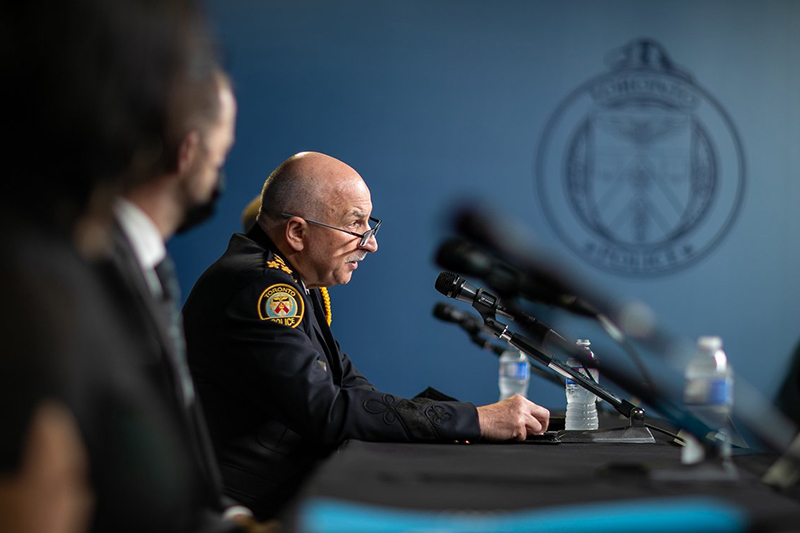With the Toronto Police Service’s release of race-based data on strip searches as part of its Race and Identity-based Data Collection Strategy, we can clearly see who it chooses to subject to strip searches.
Nearly a third of all Indigenous people who were arrested were strip-searched.
We now know that, in 2020 – even though Black people make up around 10% of the city’s population – one in every three people who were strip-searched are Black. Nearly a third of all Indigenous people who were arrested were strip-searched.
Not only does strip searching evoke racial and sexual trauma, it’s also ineffective. It’s finally time to talk about ending this oppressive police practice.
Strip searches are traumatic
For the past 20 years, the courts and watchdog agencies have tried to regulate the way police conduct strip searches, with a mind to decrease the overall number of strip searches that they conduct.
In its landmark case on strip searches, R. v. Golden (2001), the Supreme Court of Canada defined strip searches as a distinct type of “personal search”, contrasted against general, pat-down or frisk and cavity searches.
The court defined the strip search as involving “the removal or rearrangement of some or all of the clothing of a person so as to permit a visual inspection of a person’s private areas, namely genitals, buttocks, breasts … or undergarments.”
The court also acknowledged the basic intrusiveness of strip searches. They ‘represent a significant invasion of privacy’ and are often a ‘humiliating, degrading and traumatic experience’.
In the Golden case, the court also acknowledged the basic intrusiveness of strip searches. They “represent a significant invasion of privacy” and are often a “humiliating, degrading and traumatic experience.” Racialized people, as well as women, can experience being strip searched as akin to a sexual assault. Incarcerated women also view their strip searches as sexual assault.
The Supreme Court also recognized that Black and Indigenous people suffer disproportionate harm due to the racial trauma associated with being strip searched. In the absence of statistics, the majority of the Supreme Court justices in the Golden case inferred that Black and Indigenous people are “likely to represent a disproportionate number of those who are arrested by police and subjected to personal searches, including strip searches.”
According to law professor David Tanovich, the court’s endorsement of this fact established an anti-racism principle in interpreting the Charter of Rights and Freedoms.
Strip searches and systemic racism
The Toronto Police Services’ race-based data collection’s focus on strip searches is due to the efforts of provincial watchdog agencies and lawmakers in bringing the police in Ontario into compliance with the law.
In its 2019 Report, Breaking the Golden Rule: A Review of Police Strip Searches in Ontario, the Ontario Independent Police Review Director, an independent police watchdog, found that police in Ontario conduct “too many” unjustified and illegal strip searches.
Although the report didn’t delve into matters of systemic racism, the watchdog recommended that police services collect race-based data on strip searches as part of a broader police data collection project mandated by the province’s 2017 Anti-Racism Act.
Why are strip searches needed?
The justification that supposedly trumps the rights of individuals is that strip searches are necessary. But are they?
Taking into account the dragnet that police officers subject arrested people to, especially those who are brought into police custody, it’s not surprising there isn’t much left for them to find through a strip search.
Under present law, an officer may search for weapons, evidence or anything that could cause injury and assist in a person’s escape.
According to the Toronto Police Service’s procedures on searching people, police officers are expected to conduct a frisk search before contemplating a strip search. The vast majority of items are recovered during these searches.
Additionally, during the booking process, the police routinely confiscate items like shoelaces and belts. The courts have criticized police forces in Ontario – York Region and Quinte West – for confiscating underwire and string brassieres as a matter of routine procedure.
The Breaking the Golden Rule report noted that Toronto police seized bras from a third of the women they arrested from 2016 to 2019. The forced removal of these items constitutes a strip search, and routine strip searches are not justified by law.
Taking into account the dragnet that police officers subject arrested people to, especially those who are brought into police custody, it’s not surprising there isn’t much left for them to find through a strip search.
Items rarely found
In May 2014, the Toronto police chief at the time reported to the Police Services Board that only in 2% of strip and cavity searches did police find any items, and only a fraction of those found objects posed a risk.
Unfortunately, the Toronto Police Service does not offer descriptions of these items in the current race-based strip search dataset, its open data portal or its annual reports to the Toronto Police Service Board.
Given that police rarely discover dangerous items, is it really worth subjecting countless people to searches that are degrading, infringe constitutional rights and traumatizing to the Black and Indigenous people who are disproportionately searched? It’s time to end the practice.
About the Author
 Monika Lemke is a PhD Candidate in Socio-Legal Studies at York University. Her dissertation focuses on police-led strip searches in Canada, with an emphasis on their sexual and racial dimension. Her research interests include socio-legal theory, policing, body and sensory studies, the state and bureaucracy.
Monika Lemke is a PhD Candidate in Socio-Legal Studies at York University. Her dissertation focuses on police-led strip searches in Canada, with an emphasis on their sexual and racial dimension. Her research interests include socio-legal theory, policing, body and sensory studies, the state and bureaucracy.
This article first appeared on The Conversation, and is republished here under a Creative Commons Licence; the original can be read here.
Pictured top: Toronto Police Service Chief James Ramer speaking last week at a news conference about the analysis of race-based data, during which he issued an apology to Black, Indigenous and racialized people who are over-represented in use-of-force incidents and strip searches (© Toronto Police Service).


